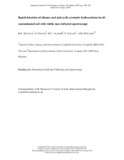JavaScript is disabled for your browser. Some features of this site may not work without it.
| dc.contributor.author | Douglas, Reward K. | |
| dc.contributor.author | Nawar, S. | |
| dc.contributor.author | Alamar, M. Carmen | |
| dc.contributor.author | Coulon, Frederic | |
| dc.contributor.author | Mouazen, A. M. | |
| dc.date.accessioned | 2018-05-23T10:20:32Z | |
| dc.date.available | 2018-05-23T10:20:32Z | |
| dc.date.issued | 2018-05-16 | |
| dc.identifier.citation | Douglas RK, Nawar S, Alamar MC, et al., (2019) Rapid detection of alkanes and polycyclic aromatic hydrocarbons in oil‐contaminated soil with visible near‐infrared spectroscopy. European Journal of Soil Science, Volume 70, January 2019, pp. 140-150 | en_UK |
| dc.identifier.issn | 1351-0754 | |
| dc.identifier.uri | http://dx.doi.org/10.1111/ejss.12567 | |
| dc.identifier.uri | http://dspace.lib.cranfield.ac.uk/handle/1826/13216 | |
| dc.description.abstract | Recent developments and applications of rapid measurement tools (RMTs) such as visible near‐infrared (vis–NIR) spectroscopy confirmed that these technologies can provide ‘fit for purpose’ and cost‐effective data for risk assessment and management of oil‐contaminated sites. Although vis–NIR spectroscopy has been used frequently to predict total petroleum hydrocarbons (TPHs), it has had limited use for polycyclic aromatic hydrocarbons (PAHs) and there has been none for alkanes. In the present study, the potential of vis–NIR spectroscopy (350–2500 nm) to measure PAHs and alkanes in 85 fresh (wet, unprocessed) oil‐contaminated soil samples collected from three sites in the Niger Delta, Nigeria, was evaluated. The vis–NIR signal and alkanes and PAHs measured in the laboratory by sequential ultrasonic solvent extraction followed by gas chromatography‐mass spectrometry (GC‐MS) were then used to develop calibration models using partial least squares regression (PLSR) and random forest (RF) modelling tools. Prior to model development, the pre‐processed spectra were divided into calibration (75%) and prediction (25%) sets. Results showed that the prediction performance of RF calibration models for both alkanes (a coefficient of determination (R2) of 0.58, a root mean square error of prediction (RMSEP) of 53.95 mg kg−1 and a residual prediction deviation (RPD) of 1.59) and PAHs (R2 = 0.71, RMSEP = 0.99 mg kg−1 and RPD = 1.99) outperformed PLSR (R2 = 0.36, RMSEP = 66.66 mg kg−1 and RPD = 1.29, and R2 = 0.56, RMSEP = 1.21 mg kg−1 and RPD = 1.55, respectively). The RF modelling approach accounted for nonlinearity of the soil spectral responses and therefore resulted in considerably greater prediction accuracy than the linear PLSR. Adoption of vis–NIR spectroscopy coupled with RF is recommended for rapid and cost‐effective assessment of PAHs and alkanes in contaminated soil. | en_UK |
| dc.language.iso | en | en_UK |
| dc.publisher | Wiley | en_UK |
| dc.rights | Attribution-NonCommercial 4.0 International | * |
| dc.rights.uri | http://creativecommons.org/licenses/by-nc/4.0/ | * |
| dc.title | Rapid detection of alkanes and polycyclic aromatic hydrocarbons in oil-contaminated soil with visible near-infrared spectroscopy | en_UK |
| dc.type | Article | en_UK |
Files in this item
The following license files are associated with this item:
This item appears in the following Collection(s)
-
Staff publications (SWEE) [2827]

